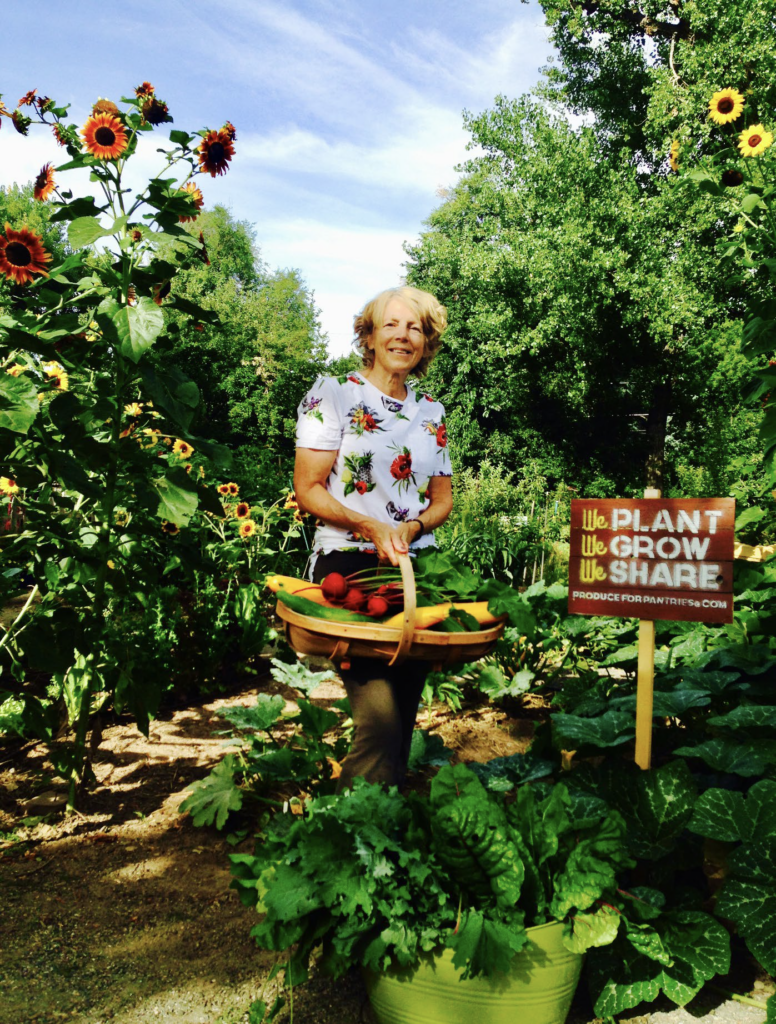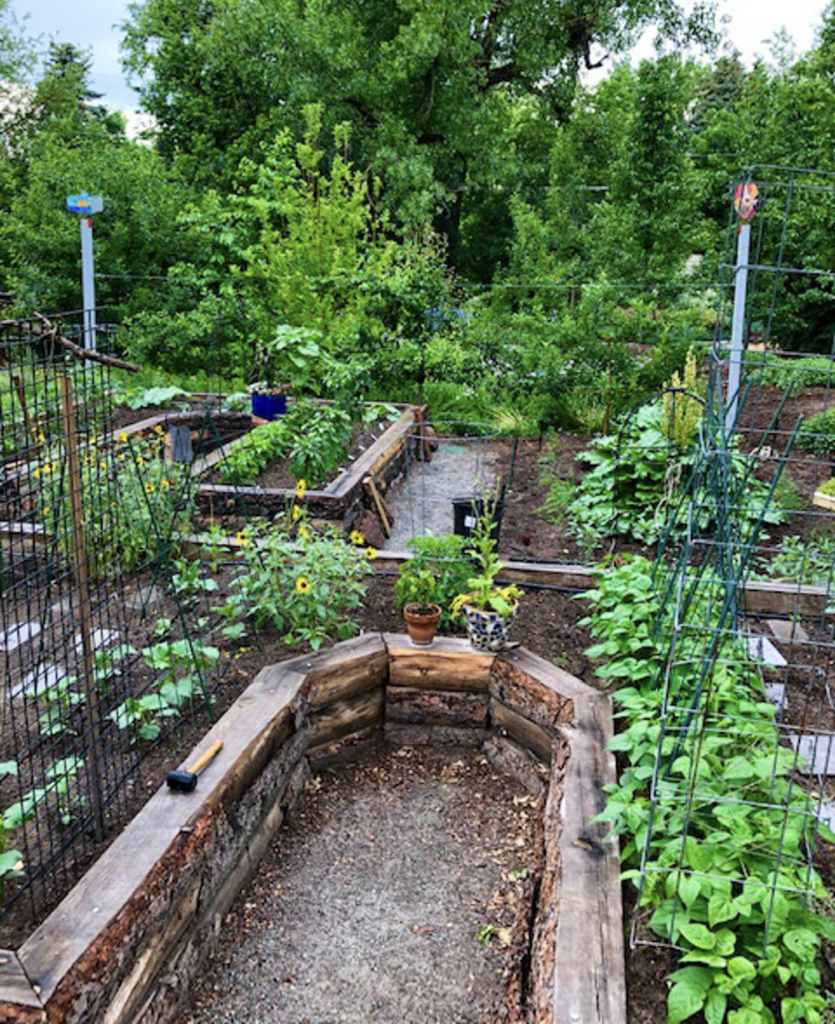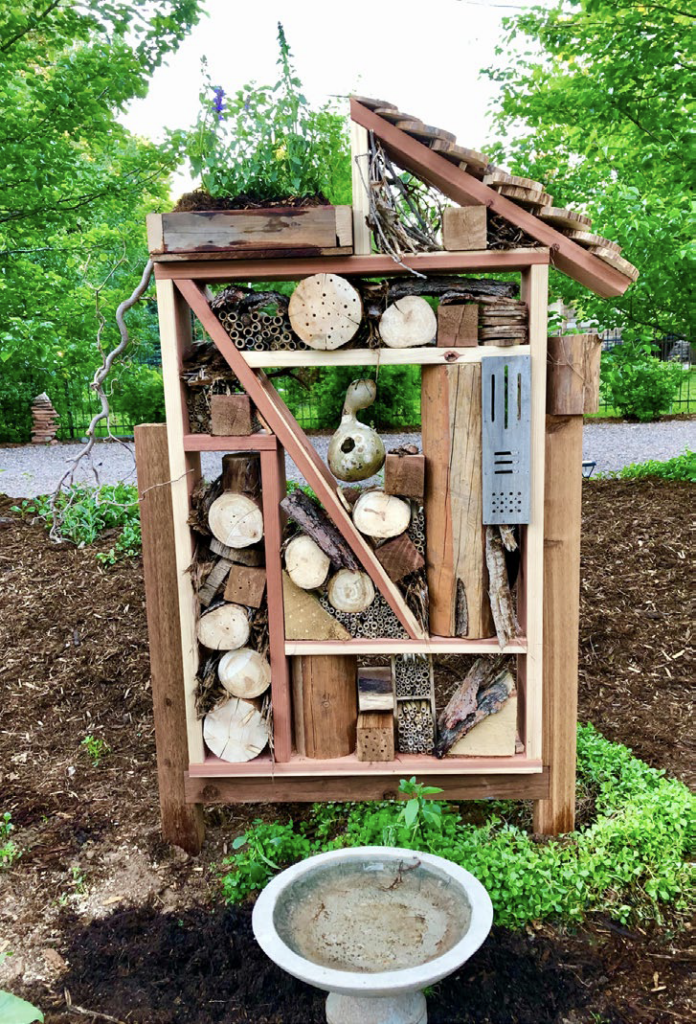Lawn. Lots and lots of lawn. But that lawn provided Donna Baker-Breningstall “a blank slate” to create the landscape she envisioned after she and her husband purchased a new home.
This is an excerpt from the Wild Ones Journal
Current members can log in to read the latest issue or check out the Journal Archives.
She and her husband, Orvin Breningstall, bought the property in 2011 and spent 10 months remodeling and adding to the two log cabins already there. They moved in 2012, and by 2013, Donna started putting in the gardens.
She first took out the overgrown junipers and the dead or dying aspen trees on the property, saving some of the trunks for other projects. Then she created a vision of things she wanted — perennial beds, vegetable beds, fruit trees and a wildflower meadow. She also consulted with the executive director of Denver Urban Gardens, who conveniently lived in the same neighborhood. And in the middle of it all, she earned her Master Gardener certification.

“I seeded the meadow with about 12 or so varieties of wildflowers, and it changes every year and season as certain plants tend to dominate,” she said. She added vegetable gardens and perennial beds. Many of the flowers are native, but not all.
“But in the last year, I’ve become more interested in natives because what is happening with birds, pollinators, global warming and water issues,” she said.
So this spring, she started taking out some of her nonnatives and developing new native areas. One area is approximately 24-feet by 8-feet; the other is 28-feet by 6-feet. Baker-Breningstall is also trying to dig out some of the nonnatives in her meadow and replace them with natives.
“It’s a process I plan to continue,” said Donna, who belongs to the Wild Ones Front Range (Colorado) chapter and the Colorado Native Plant Society. “I have a lot of nonnatives in my perennial beds, and over the next year or two, I plan to revamp those and replace with more natives. It’s just daunting and expensive to do it all at once.”
She said trying to pick a favorite area on her ½-acre property is akin to asking who is her favorite child.
“I have so many different areas on my property. One area I call my wild area; it’s in the corner by the road. It’s a little bit of mess and I like that,” she said.

Donna Baker-Breningstall poses with her garden vegetables, which she then donated to a local food pantry, Produce for Pantries.

Raised beds for growing vegetables were built with 6 x 6 timbers.
She also enjoys her raised vegetable beds she put in four or five years ago after giving up on amending the heavy clay soil on her property. She likes to walk in her meadow and enjoys the orchard with the wide variety of native bees and other pollinators, as well as her perennial beds that are chock full of color and texture.
The Baker-Breningstalls also have a custom-built garden shed with log siding in the back that is “practical, but pretty,” and a milkweed area that Donna plans to expand. “Last summer is the first time in five years that I saw a monarch,” she said. “I got so excited.”
Her favorite native plants include blanket flower (Gaillardia aristata), blue flax (Linum lewisii), common milkweed (Asclepias syriaca), Colorado blue columbine (Aquilegia caerulea), prairie coneflower (Ratibida columnifera), narrow-leaved purple coneflower (Echinacea angustifolia), little bluestem (Schizachyrium scoparium), golden current (Ribes aureum), little leaf mahogany (Cercocarpus intricatus), plains cottonwood tree (Populus deltoides ssp. monilifera) and others.
Donna said she became interested in native landscaping because of pollinators. “If you want a wide variety of pollinators and birds in your yard, you need native plants,” she said. It’s also why she added a pollinator hotel to her yard.
“It’s about 5-feet tall and 4-feet wide, and it’s an engaging structure,” she said. It is located on the north side of her vegetable beds, just east of her meadow where “there is a lot of flowering going on all around.”
Some of the pollinators that regularly visit their property include yellow and black swallowtails, monarchs, Aphrodite fritillaries, cabbage moths, mason bees, leaf cutter bees, honey bees, hummingbird moths, bats, dragonflies and others.
Baker-Breningstall said she started gardening in her 40s, after her daughters were born.
“Then the whole idea of taking care of things kicked in,” she said. “I took a couple classes, started scratching around on my own, and had successes and failures. But I received great joy in seeing plants thrive.”
In her new home, she is able to share her enthusiasm for native plants with passersby who regularly walk up her driveway just to see her gardens and curb their curiosity.

A new pollinator hotel was built with material from their property.

She also shares her enthusiasm with a small group of others who enjoy gardening, as they just started their own gardening club so they can talk about plants and learn from each other. The club is named University Park Seeders and Weeders.
Her husband hasn’t been an avid gardener, but his interest was piqued recently after he ordered some wild zinnias, which were a success. He’s also growing some Native American beans, after becoming interested when doing research for his doctorate on the Navajo reservation, Donna said.
Her advice to those new to native gardening is to go slow and do some research before you start planting.
“Know what kind of soil you have, and what kind of moisture you have coming out of the sky,” she said. “Do your homework before you start. Take classes or talk to people who are knowledgeable about natives, and maybe invite them to come over and look at your property or the area where you want to plant natives.” She also encourages people to join Wild Ones or other groups that promote native plants.
About the Yard
- The Baker-Breningstall half-acre lot is located in southeast Denver, and includes two log cabins and a variety of gardens and flowers, from a vegetable garden to an orchard, meadow and more.
- Her wildflower meadow is approximately 30 feet by 17 feet and home to some fruit trees, including apple, pear, cherry and peach.
- Some of the birds that visit their property include red-tailed hawk, rock pigeon, great horned owl, northern flicker, crow, blackcaped chickadee, white breasted nuthatch, house wren, cedar waxwing, robin, starling, house sparrow, house finch, goldfinch, spotted towhee and hummingbirds.
- A tree stump next to the road has been turned into a piece of art, a series of birdhouses. “My philosophy is that if you build it, they will come,” Donna said.
- The Baker-Breningstall garden was part of two garden tours this past June. “That’s a lot of pressure when you know more than 100 people will be coming through your garden,” she said. “It was a lot of work, but it was worth it.”
Written by Barbara A. Schmitz
All photos courtesy Donna Baker-Breningstall

